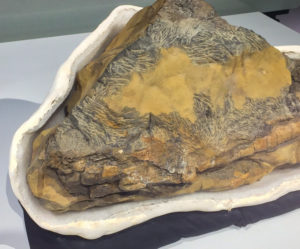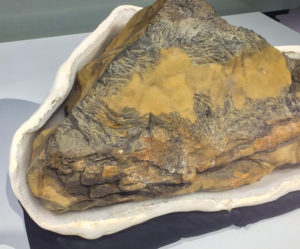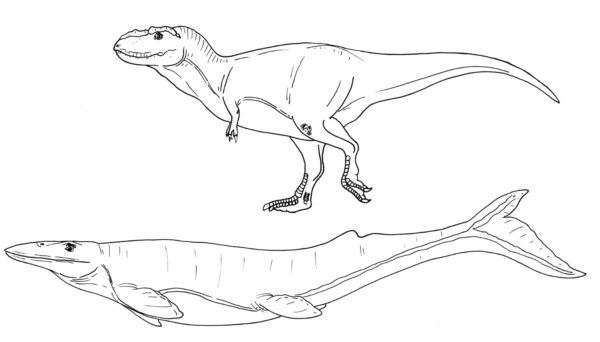
With the release of the recent Jurassic World movies and their memorable inclusion of the marine reptile Mosasaurus, it wouldn’t be surprising if this species and its mosasaurid relatives are experiencing a real uptick in popularity with the general public right now. However, like all things relating to movie depictions of extinct creatures, what you see on screen and what the fossils tell us are two different things.
Despite the film-based confusion, it’s nice to see mosasaurs getting more attention outside the more hardcore paleo-fandom. We’ve known about these animals for a long time, ever since the first mosasaur material, a set of toothed jaws, was found in the 1760’s in the Netherlands. This was decades before the first dinosaurs were scientifically described. No one at the time knew what to make of these fossils until decades later when Georges Cuvier, the ‘Father of Paleontology’, confirmed the animal’s identity as some kind of gigantic extinct lizard, citing similarities in the morphology of the bones to those of contemporary monitor lizards. The idea of extinction was brand new at the time, and these prehistoric lizard jaws provided good support for the notion that species have come and gone on the Earth for a long time.
This first specimen was eventually described as Mosasaurus in the 1820’s (Conybeare, 1822), and eventually other species from this family of large marine reptiles were found all over the world. While it’s often incorrectly said that dinosaurs are prehistoric lizards, this statement is accurate regarding mosasaurs, who are true squamates, the group that makes up all lizards. It’s long been thought that mosasaurs were closely related to monitor lizards, though other authors have placed them in a unique branch together with snakes (Reeder et al., 2015). But deciphering the ever-changing tree of lizard squamate relationships is far beyond the scope of this blog. All known mosasaur species date back to no later than the second half of the Cretaceous, but they seem to have done quite well up until the KT extinction that wiped them out along with so many of those other weird and nifty prehistoric reptiles.
Mosasaurs tend to turn up in rocks laid down in relatively shallow marine environments. It seems like they inhabited regions near coastlines, lagoons, and estuaries where they prowled the waters for fish (including sharks), ammonites, birds, and other marine reptiles like plesiosaurs and turtles. Some species, like the round-toothed Globidens, probably specialized in feeding on mollusks, using their blunt teeth to crack the shells of their prey. This was during a time when sea levels were much higher than today. Places like North Africa, the Middle East, and the North American prairies, all high and dry now, were once home to mosasaurs. Though they coexitsted with a variety of other large aquatic predators such as sharks, crocodiles, and plesiosaurs, large mosasaurs appear to have been near the top of the Cretaceous marine food chains.

A partial mosasaur jaw from northwestern Alberta, with a single tooth exposed. On display at the Philip J. Currie Dinosaur Museum. By Nicholas Carter
Despite being known to paleontologists for such a long time, and from so many specimens around the world, mosasaurs have never reached the same levels of popularity as dinosaurs. In pop culture paleontology books and documentaries, they tend to get lumped in with all the other ‘sea monsters’ that swam the Mesozoic oceans. So, having the family’s namesake animal Mosasaurus shown in the Jurassic World films was a refreshing change of pace. However, the beast shown in these movies bears very little similarity to the actual animal.
For starters, it’s WAY too big. While the movie mosasaur tends to vary in size from shot to shot, by analyzing screenshots from the films various folks on the internet have shown that it’s depicted on screen at nearly 40 meters long, and sometimes even exceeding 80 meters. Even at 40 meters long, this would make the Jurassic World Mosasaurus by far the largest animal to have ever lived. For context, the largest blue whales, the biggest living animal today, top out at around 30 meters long. Even for a prehistoric marine reptile, 40-80 meters is absurdly big. That said, the real Mosasaurus was indeed a large animal, with the biggest specimen known estimated to be around 17 meters or 56 feet long (Grigoriev, 2014). This makes it one of the largest, if not the largest, members of the mosasaurid family alongside other big species like the 14 meter North American Tylosaurus. Mosasaurus was roughly similar in length to a modern sperm whale (though probably much lighter in mass), which is pretty darn big for a lizard.

Mosasaurus shown roughly to scale alongside Tyrannosaurus. While Mosasaurus could likely have grown a fair bit longer than the dinosaur, there wasn’t a dramatic difference in their overall size. By Nicholas Carter
Soft tissue is another interesting thing we can comment on regarding the accuracy of mosasaur depictions. In the film, the Mosasaurus is depicted with a flat, paddle-shaped tail bearing some sort of fin-like spines along it. This sort of thing would have been considered accurate a few decades ago, when it was thought that mosasaurs swam like giant eels, with undulating tail strokes. The movie Mosasaurus also seems to have rows of osteoderms running down its back, similar to what we see in crocodiles, and overall its skin texture seems to have been largely inspired by crocodilians with the knobbed backs and shrink-wrapped heads. Thanks to some mosasaur remains that bear skin impressions, we know that these animals weren’t actually like giant crocodiles, but had a more snake-like covering. Skin impressions show small, overlapping, diamond-shaped scales covering the body, with the scales on the dorsal surface bearing small keels along their length (Snow, 1978) (Kaddumi, 2009). This would’ve made mosasaurs very sleek, streamlined animals, which is a good trait to have for a large marine hunter.
Mosasaurs undoubtedly got around in the water by heavily relying on their tails to propel them. However, we now know that reconstructions of them slithering around like sea snakes are incorrect. It seems like at least some, if not all mosasaurs, had down-ward projecting tail tips, with crescent-shaped flukes on top of this downward bend used for propulsion (Lindgren et al., 2010). A similar feature also evolved independently in ichthyosaurs, another group of reptiles adapted to an extremely marine existence. Also like ichthyosaurs, it’s probable that derived mosasaurs were incapable of hauling themselves onto land to lay their eggs like modern sea turtles are forced to do, so mothers likely retained their eggs inside them until after hatching, giving birth to live young capable of swimming on their own.
It may not have been impossible for Mosasaurus to have launched itself out of the water to snatch flying prey from the air as is seen in the film, but I suspect that if it did happen, it was a rare occurrence. There would have been perfectly adequate prey available under the water’s surface for this animal. However, I don’t think it’s inconceivable that Mosasaurus and its sizeable relatives at least sometimes came up on swimming prey from beneath in deep enough water, and may have risen some ways out of the water during these attacks in a similar manner to some sharks and predatory whales today.
Some soft-tissue remains are so well preserved that we can even get a sense of what colour mosasaurs were thanks to pigment found within the fossilized scales. It seems like at least some mosasaurs, perhaps including Mosasaurus itself, were counter-shaded (Lindgren et al., 2014). This is a type of colouration where the top half, or dorsal side, of an animal is darker in shade than the lower, or ventral, side. This type of shading is seen in many sharks, delphinids, and the leatherback turtle, and is used as a method of aquatic camouflage.
A look into the gaping jaws of the Mosasaurus from Jurassic World shows some interesting features as well. First off, the texture of the face is much too crocodile-like. All modern lizards have lips and gums that fill out the snout and obscure the view of their teeth, and there’s little reason to think that mosasaurs were any different. You can, however, spot teeth on the roof of the animal’s mouth in the film, which actually is accurate. Mosasaurs had small teeth on their palatal bones that were useful for keeping a good grip on their prey, a feature seen in other groups of lizards, including snakes. It’s also been suggested that mosasaurs had forked tongues in life due to the presence of openings in their palates (Schulp et al., 2005), so the movie mosasaur could probably do with one. The forked tongues seen in snakes and many lizards are sensitive organs used for locating prey, so perhaps mosasaurs used them for finding things to eat in the vast Cretaceous seas.
There’s a few different species of Mosasaurus, and it seems like this large, late Cretaceous reptile was able to spread into a number of locations thanks to high sea levels at the time. The giant type species originally found in the Netherlands, Mosasaurus hoffmanni, is found throughout Europe and is also known from South Dakota (Harrell & Martin, 2014). One species that may have been present in Alberta during the Campanian times, Mosasaurus conodon, is found in Colorado and Montana from rocks laid down in the Western Interior Seaway (Ikejiri & Lucas, 2014). The genus Mosasaurus was used as a waste-basket taxon for decades by early paleontologists, and so it’s taken some work to figure out which species are valid and which are not.
So that’s a summary of what we know about the real Mosasaurus. As with so many of the dinosaurs it shared the planet with, this animal’s fame among the public often comes at the expense of scientific accuracy. There’s nothing wrong with enjoying some fun on the movie screen, but it’s always worth remembering that the Mosasaurus is every bit as cool as its Hollywood counterpart. It’s wonderful to imagine this huge mysterious creature lurking in the prehistoric oceans, a thought that takes us back to when the planet was younger and sea monsters were real.
By Nicholas Carter
References
Conybeare, W. D. 1822. Mosasaurus.—The saurus of the Meuse, the Maestricht animal of Cuvier. In An Introduction to the Study of Fossil Organic Remains (ed. Parkinson, J.), pp. 298. London: Sherwood, Neely and Jones, and W. Phillips.
Grigoriev, D.W. (2014). “Giant Mosasaurus hoffmanni (Squamata, Mosasauridae) from the Late Cretaceous (Maastrichtian) of Penza, Russia” (PDF). Proceedings of the Zoological Institute RAS. Russia. 318 (2): 148–167.
Harrell, T. L.; Martin, J. E. (2014). “A mosasaur from the Maastrichtian Fox Hills Formation of the northern Western Interior Seaway of the United States and the synonymy of Mosasaurus maximus with Mosasaurus hoffmanni (Reptilia: Mosasauridae)”. Netherlands Journal of Geosciences – Geologie en Mijnbouw. 94: 23–37.
Ikejiri, T.; Lucas, S. G. (2014). “Osteology and taxonomy of Mosasaurus conodon Cope 1881 from the Late Cretaceous of North America”. Netherlands Journal of Geosciences – Geologie en Mijnbouw. 94: 39–54.
Kaddumi, H.F. (2009). “On the latest scale coverings of mosasaurs (Squamata: Mosasauridae) from the Harrana Fauna in addition to the description of a new species of Mosasaurus”. Fossils of the Harrana Fauna and the Adjacent Areas. Amman: Eternal River Museum of Natural History. pp. 80–94.
Lindgren, J.; Caldwell, M.W.; Konishi, T.; Chiappe, L.M. (2010). Farke, Andrew Allen (ed.). “Convergent Evolution in Aquatic Tetrapods: Insights from an Exceptional Fossil Mosasaur”. PLoS ONE. 5 (8): e11998. Bibcode:2010PLoSO…511998L. doi:10.1371/journal.pone.0011998
Lindgren, J.; Sjövall, P.; Carney, R. M.; Uvdal, P.; Gren, J. A.; Dyke, G.; Schultz, B. P.; Shawkey, M. D.; Barnes, K. R.; Polcyn, M. J. (2014). “Skin pigmentation provides evidence of convergent melanism in extinct marine reptiles”. Nature. 506 (7489): 484–8.
Reeder, Tod W.; Townsend, Ted M.; Mulcahy, Daniel G.; Noonan, Brice P.; Wood, Perry L.; Sites, Jack W.; Wiens, John J. (2015). “Integrated Analyses Resolve Conflicts over Squamate Reptile Phylogeny and Reveal Unexpected Placements for Fossil Taxa”. PLOS ONE. 10 (3): e0118199. doi:10.1371/journal.pone.0118199
Schulp, A. S.; Mulder, E. W. A.; Schwenk, K. (2005-09-01). “Did mosasaurs have forked tongues?”. Netherlands Journal of Geosciences. 84 (3): 359–371.
Snow, F. H. (1878). “On the dermal covering of a mosasauroid reptile”. Transactions of the Kansas Academy of Science. 6: 54–58.

